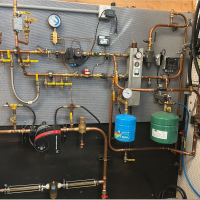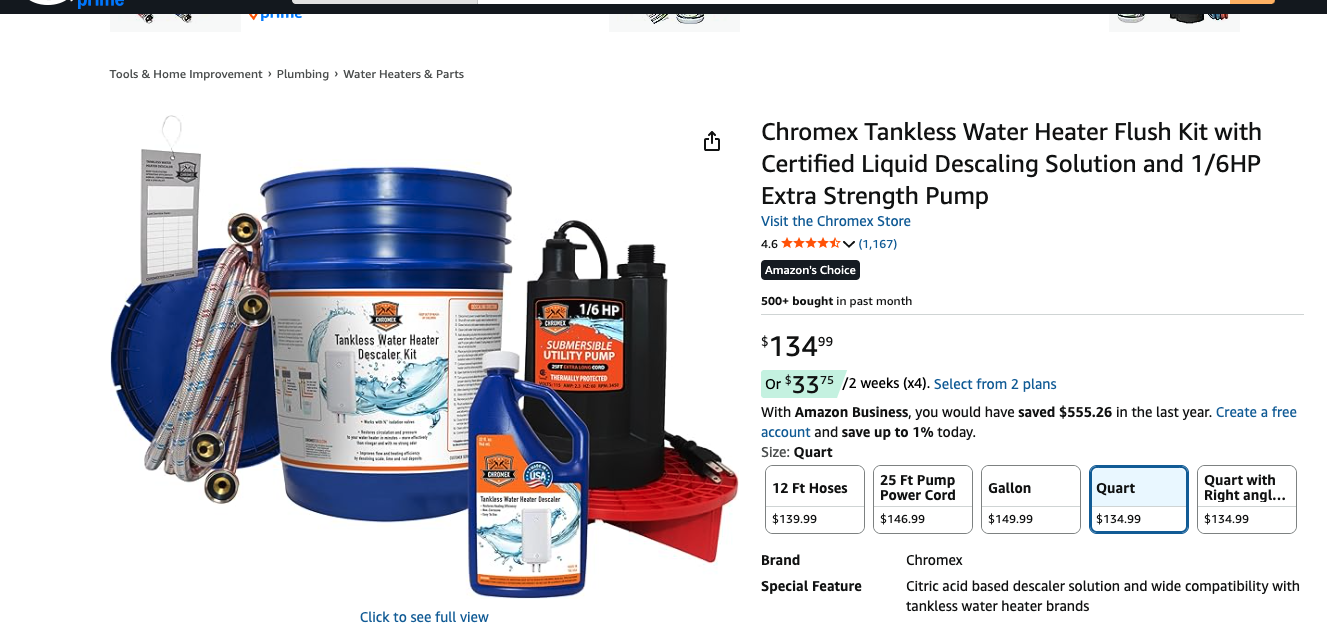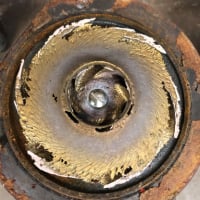Any ideas why this pump keep going bad?
Good morning.
I have this pump on a copper fin boiler, making domestic hot water for a commercial laundromat. It seems like every 6 to 12 months the cartridge will go bad or it will start leaking. Then every 2 to 3 years the thing just completely breaks down and needs to be replaced in its entirety. The entire pump was replaced eight months ago and now it's leaking. The previous pump worked fine for about 10 years.
It's a 399k btu Natco boiler feeding an 80 gallon storage tank. the pump is a Taco 0011 Stainless. Prior pump was a Taco 0011 bronze. Boiler is probably 20-30 years old. Water pressure is in the 80s. They do get some hammering from the machines.
I called Natco who said the 0011 should work but a 0012 would be best. They're looking for 17-20gpm at 10-14'. He doesn't think that it would make the pumps go bad though.
Any thoughts? Part of me wants to blame the pump sizing but it worked that way for many years. I'm thinking maybe the heat exchanger is getting clogged with calcium after many years of heavy use and wrecking the pumps.
Comments
-
Maybe you need a pressure reducing valve. 80PSI is pretty high.
Taco monitors this site so they will probably respond.
0 -
Hi, I hear three possible problems. High pressure, water hammer, and possibly poor flow through the pump…FYI, I have seen a gas water heater at a laundromat have its' flue collapsed by water hammer.
Is there a place close to the pump where you can put a pressure gauge… the type that has a red needle that indicates highest pressure reached? Also, can you have a look at the pump with an IR camera? That might indicate whether poor flow and overheating of the pump are concerns. And as Ed mentioned, does it need to be up at 80 psi? That's just going to be harder on all of the equipment.
Yours, Larry
1 -
I have about 30' feet to the highest fixture in the building so going down to 60 psi certainly wouldn't kill them. Ill leave a gauge on the water heater drain and check the highest pressure. The person I spoke to at Taco didn't seem to think 80lbs would be a pump killer. He was more concerned about low pressure and pump orientation.
I could check the pump with an IR camera. Are you talking about the temperature of the actual pump itself to make sure it's not overheating? I didn't think of that and will check it out though with the leak it may now be cooling itself.0 -
my bet would be on scaling from hard water, or water hammer. Or both.
That pump is rated to 125 psi.
A lazy hand gauge would capture spikes. 80 psi is about the high side of the pressure. Do you need it that high? Lowering it to 50 or 60 would help all the plumbing components. 80 psi can spikes to over 300 psi with a hammer and spike.
Any application with fast closing solenoids needs water hammer arestors. Maybe one at the end of the supply to the machines. High flow rates and high pressure against a fast acting valve are a big concern.
If you have arrestors they could be damaged
You can get arrestors that go on the individual hose connection, or a large size to cover multiple machines
Bob "hot rod" Rohr
trainer for Caleffi NA
Living the hydronic dream1 -
-
Thermal expansion tanks may help.
Ideally, according to Sioux Chief, the arrestor should be at the device that causes the hammer. You need an air pocket to absorb the shock wave, catch it before it travels the length of the piping.
So they make mini arrestors for washers, icemakers dishwashers, hose bibs and whole building type.
Water hammer can also cause BFDs to spray, the dual checks at boiler fill valves are susceptible to this shock wave and the droop below static is what causes a quick spurt.
Some installers claim a swing check upstream of a BFD can catch and break the shock wave and protect the BFD?
Bob "hot rod" Rohr
trainer for Caleffi NA
Living the hydronic dream0 -
If all of the above doesn't help, would swapping out the 0011…or 0012 with this circulator be a recommendation from Taco?
Its a Stainless model head three piece.
0 -
I thought about that. I think it sizes out to a 113. Whomever I spoke to at Taco couldn't really give me any definitive answers and I really don't want to put that pump on there and have the same issue. The pump is 2 grand and a replacement bearing assembly on it is what a new 0011 costs.
0 -
There is a thermal expansion tank on the cold inlet. Installation isn't great with no support but it's there, the tank is good and it's pressurized to street pressure.
I don't like the idea of putting 40 arrestors behind the machines. When they start to go bad it's going to be a process to determine which one it is. I could do one on the rise up from the basement. I think should protect the pump at least.0 -
-
Depending on what is in the water, both chemical and particulate, 3 piece circulators can be more tolerant of the water composition than wet rotor circulators.
But that doesn't explain why it worked for a while and now it doesn't. maybe the chemistry was more compatible with bronze than stainless.
0 -
-
That gauge shown above will determine if you have spikes. Spikes could be from water hammer, or the city line pressure could be spiking.
Depending on that tank size and volume of the entire system, that thermal expansion tank may be undersized.
I would not install 40 arrestors either. A large one at the end of the row of washers might be a good placement. Close to the machines as possible.
Bob "hot rod" Rohr
trainer for Caleffi NA
Living the hydronic dream0 -
first thing, take an amp meter reading when the pump is running at full capacity. That’s a good way to see if the pump is operating within its capacity. Your reading should be at nameplate amps. Less than nameplate indicates running close to dead head. Over amping indicates your pump might be trying to exceed its capacity. Your expansion tank should equal your static pressure in the system, best way to check is to isolate the tank; you need equilibrium pressure to avoid over pressurized system. Not sure why cartridge was replaced, but that can tell a story too. The tech support team at 401-942-8000 can further assist if you have data I suggested.
Joe Mattiello
N. E. Regional Manger, Commercial Products
Taco Comfort Solutions1 -
Nice thing about going with a 3 piece pump, you would only have to change the bearing assembly in the event of a failure. What does the inside of the failed pump look like? Is there a lot of iron? That being a boiler that's designed for domestic water it should have bronze or brass headers. Maybe, eliminating the black iron piping and elbow just above the pump might cut down on the iron and the electrolysis.
0 -
Those are brass elbows. Everything on the system is brass, copper or stainless. While being able to replace just the bearing assembly is nice the bearing assembly costs what a whole 0011 costs.
0 -
regardless if you use a 1, 2, or 3 piece pump, you want to figure out the cause of the failures. A pump like that, in clean water, should last 10 years or more.
Any results from the pressure test?
Bob "hot rod" Rohr
trainer for Caleffi NA
Living the hydronic dream0 -
The difference in a 0011 or a 0012 at the specs from Natco is very minimal, however, once you get away from those design numbers, the difference between the two pumps is drastic. If the system is scaled up, head loss has increased, the amp reading like Joe mentioned tells alot.
Changing to a three piece circ at those numbers is also fine but rather than keep replacing or changing circs, we need to diagnose why. To keep doing the same thing to expect different results each time is not helping the situation.
I would rather find what the cause is, the hammering is the most probable. The boiler has been there for 30 years, the first pump was there for a long time as well, so what's changed?
My guess is the washing machines have changed! The solenoid valves in the old machines probably didn't close as fast as they now in newer machines creating more havoc in the system. Treat the symptom, not the result is my thoughts without being there.
Dave Holdorf
Technical Training Manager - East
Taco, Inc
1 -
I feel your pain. If you had a longer piping run, I would add some ball valves and hose bibs that would allow you to flush the boiler's heat exchanger with an approved cleaner. You can still do it with some creative tees in the line. And get rid of the 0011 and go with the 0012 as you don't need all that head.
8.33 lbs./gal. x 60 min./hr. x 20°ΔT = 10,000 BTU's/hour
Two btu per sq ft for degree difference for a slab0 -
Thank you.
I got there today and replaced the pump. The amperage is slightly high, 1.95 and settled to 1.85 reading, 1.76 rated. The pump was is the process of self destructing. The water leaking onto the floor was making its way into the windings then out.Last time the cartridge was changed because the pump was making noise for a while then it seized up. Three months after the cartridge replacement this exact thing happened with water going back into the windings. Nobody caught it that time and it fried the ignition module.
The expansion tank is properly pressurized. I double checked it.I'm not sure if it would matter but I will throw it out there. The piping from water heater to the tank used to be 1-1/2". The inch and a half pipe kept wearing through every few years so it was changed to 2" and that problem went away. The boiler tappings are 1.5". The wear on the pipe was from circulation, not a water quality issue. There's a ton of copper in the building and there has never been a pinhole anywhere else. You could actually see the thin spots in the piping where it was wearing away from flow.
I will give a call tomorrow and see what tech support has to say.
0 -
Just wanted to say thank you to everyone for their help so far.
0 -
Exactly. There's something going on here. I need to figure out what changed. The old 0011 ran fine for many years. The only thing I can think of are the hammer or a failing heat exchanger.
The amperage is a little off. Would being over by an eighth of an amp kill pumps like that?
I did order a couple hammer arrestors. I'm going to put on the lines where they come downstairs about 15' from the hot water system.
0 -
Were there stainless pumps that lasted for years or only bronze? Stainless really doesn't like water with high chloride content.
0 -
If I was sure the 0012 would fix everything I would and if this thing goes bad again and I buy a new pump I will. I just hate throwing a $600 pump at it saying maybe this will work. The original 0011 ran for many years. I feel like something else must be going on here.
If it comes down to the heat exchanger being calcified that's the plan. I'm going to have to cut in some tees and a valve y to flush it.0 -
The old one that lasted was bronze. I could be wrong, but I believe the only thing that changed was the housing. All the other wetted surfaces I think have always been stainless?
0 -
what temperature is it running? The hotter the water the more aggressive. Water quality along with high velocity and hot water, over 140 will wear out copper tube
The copper tube association suggests 2-3 gps if the water is above 140 F
Any idea what the flowrates is or what the boiler manufacturer requests? Here is an online example of velocity/ gpm. I would guess 2” minimum.
Tube pinhole is often velocity related. Reaming the tube is also important.
Is the water softened?
I would take a sample of the water to a lab or local water treatment expert. Hardness, tds, chloride, chlorine or chloramine. Local water treatment companies generally know what is in. The local water.
You have an open loop system, so a thermal expansion tank, properly sized is what you need. The precharge is based on incoming water pressure. Which will vary a bit in DHW systems.
Bob "hot rod" Rohr
trainer for Caleffi NA
Living the hydronic dream0 -
here is the required flow rate on one of the Natco models. Look up your exact model to get the best info.
Some pump info, once you determine the required flow. I would think a flat curve circ like an 0910? The boiler manufacturer would know best
Bob "hot rod" Rohr
trainer for Caleffi NA
Living the hydronic dream0 -
Water is not hard. Temp is 125. Changing the tube to 2"'and/or reeming it solved the issue. It does have an expansion tank. I was just throwing that out there as something else that has changed on the system trying to get the the bottom of this pump thing.
0 -
All these things point to a happy pump life.
I'm still thinking something like a 300 psi pressure spike, caused by a water hammer could blow out the pump cartridge.
Some reading from Nibco on water hammer.
Bob "hot rod" Rohr
trainer for Caleffi NA
Living the hydronic dream0 -
Here we are eight months later and the pump has sure enough went out again. This time I was able to swap it for the larger 0012 and get some hammer arrestors close to the machines. I'm hoping that helps.
I do still see is the new 0012 pulling double the amps it should be. This is better than what the 0011 was pulling so it's a start. Interestingly I put a used 0010 I had on to get them through the weekend. That pulled 5x its rated amperage. I'm thinking of tossing a gate valve on the line and trying to throttle it a bit to get the power draw in spec.
0 -
Have you tried running a descaler through the boiler? If the pump cannot flow enough you are running it way up it's curve in an unhealthy condition.
You need to try something other than replacing pumps.
If you can isolate the boiler from the piping, add a few hose connections these descale kits work very well and quickly. No harm in flushing that boiler.
And it is cheaper than a new pump :)
Bob "hot rod" Rohr
trainer for Caleffi NA
Living the hydronic dream1 -
If you're pulling high amps and the rotor isn't binding then you're likely running way to the right of the curve. The left end of the curve is deadheading and has low amp draw because no water is actually moving. The right end of the curve is maximum power use because it's not making much pressure but it's making a ton of flow.
Adding a valve on the discharge to force some discharge head for testing isn't a bad idea if its something you can do easy enough. I'd suggest using a ball valve over gate for throttling though. Watch your amp draw as you throttle it down. As you close the valve more, the amp load should drop because your shifting your operating point on the curve to the left.
0 -
Does the impeller of the old pump rotate freely? I would cut off the end of the cartridge and look inside especially if it doesn't rotate freely. I have done that and found the cartridge loaded with magnetite. I would change the pipe input to the pump to copper and lengthen the input to the pump to 10 dia of straight pipe and the output to 5 pipe dia of straight pipe.
I have found blk iron pipe corroded inside to the point where the the opening was 3/4 restricted. The greater the load on a pump the higher the current draw. Iron is a source of magnetite.
If you place the load wire in the center of the opening of your volt meter, when you measure, instead of against the edge you may get a different amp reading.
I would consider an equivalent Grundfos pump. I always change the volute with the pump, however, if the stainless volute is in good order and from the same pump specs, then I would re use it.
0
Categories
- All Categories
- 87.3K THE MAIN WALL
- 3.2K A-C, Heat Pumps & Refrigeration
- 61 Biomass
- 427 Carbon Monoxide Awareness
- 119 Chimneys & Flues
- 2.1K Domestic Hot Water
- 5.8K Gas Heating
- 115 Geothermal
- 165 Indoor-Air Quality
- 3.7K Oil Heating
- 76 Pipe Deterioration
- 1K Plumbing
- 6.5K Radiant Heating
- 395 Solar
- 15.6K Strictly Steam
- 3.4K Thermostats and Controls
- 56 Water Quality
- 51 Industry Classes
- 49 Job Opportunities
- 18 Recall Announcements














